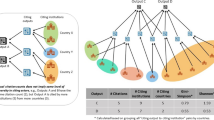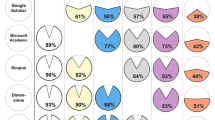Abstract
This study investigates the evolution and structure of a national-scale co-publishing network in Korea from 1948 to 2011. We analyzed more than 700,000 papers published by approximately 415,000 authors for temporal changes in productivity and network properties with a yearly resolution. The resulting statistical properties were compared to findings from previous studies of coauthorship networks at the national and discipline levels. Our results show that both the numbers of publications and authors in Korea have grown exponentially in a 64 year time frame. Korean scholars have become more productive and collaborative. They now form a small-world-ish network where most authors can connect with one other within an average of 5.33 degrees of separation. The increasingly skewed distribution and concentration of both productivity and the number of collaborators per author indicate that a relatively small group of individuals have accumulated a large number of opportunities for co-publishing. This implies a potential vulnerability for the network and its wider context: the graph would disintegrate into a multitude of smaller components, where the largest one would contain <2 % of all authors, if approximately 15 % (57,724) of the most connected scholars left the network, e.g., due to retirement or promotion to higher-level administrative positions.










Similar content being viewed by others
Notes
More than 97 % of the authors identified were found to be associated with universities, institutes, or companies in Korea. Although there might be scholars who reside overseas and may participate in papers published in Korea, we assume that that does not affect our study.
In our study, a power law distribution is fitted to the observed degree distribution using the maximum-likelihood fitting method with the goodness-of-fit test based on the Kolmogorov–Smirnov statistic as described in Clauset et al. (2009).
A graph-level Watts–Strogatz clustering coefficient is the average of the ego network densities of all authors.
The coauthorship networks in our study were constructed by converting an author-by-paper matrix (i.e., two-mode or bipartite network) into an author-by-author matrix (i.e., one-mode or monopartite network). Several scholars have proposed to compare bipartite graphs (e.g. networks of interlocking directors/companies or inventors/patents) against bipartite random graphs. For more details, please refer to Robins and Alexander (2004) or Kogut and Belinky (2008).
This interpretation needs to be taken with caution. Even though a path is relatively short, most potential within and across field collaborations will not be realized.
For example, one topic for further investigations might be to analyze whether the increased productivity and connectivity are due to new cohorts of scientists who truly are more productive than more established scholars, or because scholars who have been in a field for many years have accumulated a multitude of publications.
References
Abramo, G., D’Angelo, C. A., & Murgia, G. (2013). The collaboration behaviors of scientists in Italy: A field level analysis. Journal of Informetrics, 7(2), 442–454. doi:10.1016/j.joi.2013.01.009.
Abt, H. A. (2007). The future of single-authored papers. Scientometrics, 73(3), 353–358. doi:10.1007/s11192-007-1822-9.
Barabási, A. L., Jeong, H., Neda, Z., Ravasz, E., Schubert, A., & Vicsek, T. (2002). Evolution of the social network of scientific collaborations. Physica A—Statistical Mechanics and Its Applications, 311(3–4), 590–614. doi:10.1016/s0378-4371(02)00736-7.
Börner, K., Maru, J. T., & Goldstone, R. L. (2004). The simultaneous evolution of author and paper networks. Proceedings of the National Academy of Sciences of the United States of America, 101(suppl. 1), 5266–5273. doi:10.1073/pnas.0307625100.
Brandes, U. (2001). A faster algorithm for betweenness centrality. Journal of Mathematical Sociology, 25(2), 163–177.
Çavuşoğlu, A., & Türker, İ. (2013). Scientific collaboration network of Turkey. Chaos, Solitons and Fractals, 57, 9–18.
Chen, Z. F., & Guan, J. C. (2010). The impact of small world on innovation: An empirical study of 16 countries. Journal of Informetrics, 4(1), 97–106. doi:10.1016/j.joi.2009.09.003.
Choi, S.-H., Kim, B.-K., Kang, M., You, B.-J., Lee, J., & Park, J.-W. (2011). A study of citing patterns of Korean scientists on Korean journals. Journal of the Korean Society for Information Management, 28(2), 97–115.
Clauset, A., Shalizi, C. R., & Newman, M. E. J. (2009). Power-law distributions in empirical data. SIAM review, 51(4), 661–703.
Cowan, R., & Jonard, N. (2004). Network structure and the diffusion of knowledge. Journal of Economic Dynamics and Control, 28(8), 1557–1575. doi:10.1016/j.jedc.2003.04.002.
Fegley, B. D., & Torvik, V. I. (2013). Has large-scale named-entity network analysis been resting on a flawed assumption? PLoS ONE, 8(7), 1–16. doi:10.1371/journal.pone.0070299.
Franceschet, M. (2011). Collaboration in computer science: A network science approach. Journal of the American Society for Information Science and Technology, 62(10), 1992–2012. doi:10.1002/asi.21614.
Glasser, G. J. (1962). Variance formulas for the mean difference and coefficient of concentration. Journal of the American Statistical Association, 57(299), 648–654. doi:10.2307/2282402.
Gossart, C., & Özman, M. (2009). Co-authorship networks in social sciences: The case of Turkey. Scientometrics, 78(2), 323–345. doi:10.1007/s11192-007-1963-x.
Grossman, J. W. (2002). Patterns of collaboration in mathematical research. SIAM News, 35(9), 8–9.
Han, S. H., Cho, S. R., Yang, J. M., & Ryu, D. A. (2009). A study on academic research and development activities in Korea. Seoul: National Research Foundation of Korea.
Kim, M.-J. (2005). Korean science and international collaboration, 1995–2000. Scientometrics, 63(2), 321–339.
Kim, J., & Diesner, J. (2015). The effect of data pre-processing on understanding the evolution of collaboration networks. Journal of Informetrics, 9(1), 226–236. doi:10.1016/j.joi.2015.01.002.
Kim, J., Kim, H., & Diesner, J. (2014). The impact of name ambiguity on properties of coauthorship networks. Journal of Information Science Theory and Practice, 2(2), 6–15. doi:10.1633/JISTaP.2014.2.2.1.
Kogut, B., & Belinky, M. (2008). Comparing small world statistics over time and across countries: An introduction to the special issue comparative and transnational corporate networks. European Management Review, 5(1), 1–10. doi:10.1057/emr.2008.6.
Liben-Nowell, D., & Kleinberg, J. (2007). The link-prediction problem for social networks. Journal of the American Society for Information Science and Technology, 58(7), 1019–1031. doi:10.1002/asi.20591.
Lužar, B., Levnajić, Z., Povh, J., & Perc, M. (2014). Community structure and the evolution of interdisciplinarity in Slovenia’s scientific collaboration network. PLoS ONE, 9(4), e94429. doi:10.1371/journal.pone.0094429.
Martin, T., Ball, B., Karrer, B., & Newman, M. E. J. (2013). Coauthorship and citation patterns in the physical review. Physical Review E, 88(1), 012814-1–012814-9. doi:10.1103/PhysRevE.88.012814.
Merton, R. K. (1968). Matthew effect in science. Science, 159(3810), 56. doi:10.1126/science.159.3810.56.
Ministry of Education. (2013). Statistical yearbook of education. Seoul, Korea: Ministry of Education.
Moody, J. (2004). The structure of a social science collaboration network: Disciplinary cohesion from 1963 to 1999. American Sociological Review, 69(2), 213–238.
Newman, M. E. J. (2000). Models of the small world. Journal of Statistical Physics, 101(3–4), 819–841. doi:10.1023/A:1026485807148.
Newman, M. E. J. (2001). The structure of scientific collaboration networks. Proceedings of the National Academy of Sciences of the United States of America, 98(2), 404–409. doi:10.1073/pnas.021544898.
Newman, M. E. J. (2004). Coauthorship networks and patterns of scientific collaboration. Proceedings of the National Academy of Sciences of the United States of America, 101(suppl. 1), 5200–5205. doi:10.1073/pnas.0307545100.
Newman, M. E. J. (2010). Networks: An introduction. Oxford: Oxford University Press.
Park, H. W., & Leydesdorff, L. (2008). Korean journals in the Science Citation Index: What do they reveal about the intellectual structure of S&T in Korea? Scientometrics, 75(3), 439–462.
Perc, M. (2010). Growth and structure of Slovenia’s scientific collaboration network. Journal of Informetrics, 4(4), 475–482.
Robins, G., & Alexander, M. (2004). Small worlds among interlocking directors: Network structure and distance in bipartite graphs. Computational and Mathematical Organization Theory, 10(1), 69–94. doi:10.1023/B:CMOT.0000032580.12184.c0.
Ryoo, J. W. (2011). The labor market for college professors in Korea. Korean Journal of Labor Economics, 34(2), 1–27.
Schubert, A., & Glanzel, W. (2006). Cross-national preference in co-authorship, references and citations. Scientometrics, 69(2), 409–428. doi:10.1007/s11192-006-0160-7.
Strotmann, A., & Zhao, D. (2012). Author name disambiguation: What difference does it make in author-based citation analysis? Journal of the American Society for Information Science and Technology, 63(9), 1820–1833. doi:10.1002/Asi.22695.
Torvik, V. I., & Smalheiser, N. R. (2009). Author name disambiguation in MEDLINE. Acm Transactions on Knowledge Discovery from Data, 3(3), 1–29. doi:10.1145/1552303.1552304.
Uzzi, B., & Spiro, J. (2005). Collaboration and creativity: The small world Problem1. American Journal of Sociology, 111(2), 447–504.
Waltman, L. (2012). An empirical analysis of the use of alphabetical authorship in scientific publishing. Journal of Informetrics, 6(4), 700–711. doi:10.1016/j.joi.2012.07.008.
Watts, D. J., & Strogatz, S. H. (1998). Collective dynamics of ‘small-world’ networks. Nature, 393(6684), 440–442.
Yoshikane, F., & Kageura, K. (2004). Comparative analysis of coauthorship networks of different domains: The growth and change of networks. Scientometrics, 60(3), 435–446. doi:10.1023/b:scie.0000034385.05897.46.
Acknowledgments
This work is supported by KISTI (Korea Institute of Science and Technology Information), grant P14033. The American Physical Society (APS, http://journals.aps.org/datasets) kindly provided the publication records of the Physical Review journals for our research. We would like to thank Brian Karrer (Facebook), Travis Martin (University of Michigan), Brian Ball (Dotomi Inc.) and Mark E. J. Newman (University of Michigan) for helping us to disambiguate author names in the APS dataset. We also thank the anonymous reviewers who helped us improve the quality of this paper, and Susan Lafferty (GSLIS, University of Illinois at Urbana-Champaign) for editing the manuscript.
Author information
Authors and Affiliations
Corresponding author
Rights and permissions
About this article
Cite this article
Kim, J., Tao, L., Lee, SH. et al. Evolution and structure of scientific co-publishing network in Korea between 1948–2011. Scientometrics 107, 27–41 (2016). https://doi.org/10.1007/s11192-016-1878-5
Received:
Published:
Issue Date:
DOI: https://doi.org/10.1007/s11192-016-1878-5




